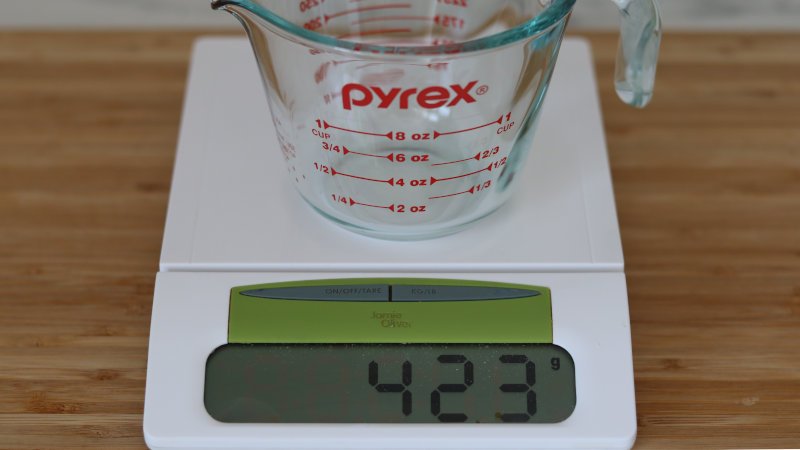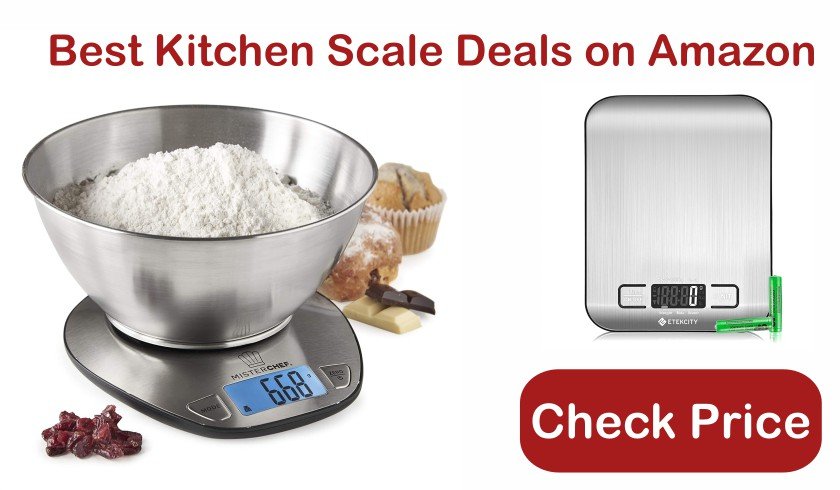Digital kitchen scales have become more sophisticated over the last years. Some of them have a super stylish design, most of them can weigh your ingredients in several different units of measurement (g, kg, oz, lbs). But there are some that even tell you liquid (or volume) measurement, like fl oz, on their display. But how does a scale measure fluid ounces? How to measure fl oz on a scale?
The Quick Answer
Sorry to disappoint you, but the quick answer is that a kitchen scale is not able to measure liquid ingredients.
Why do you see them fl oz or ml (milliliter) measurement on your kitchen scale? This is mainly a marketing trick from food scale manufacturers, adding a feature to their product that can sometimes be beneficial but other times even ruin your recipe.
You can still use your kitchen scale to measure out some liquid ingredients, but you need to understand the concept. So keep on reading to find out the answer to how to measure fl oz on a scale.
How to Measure fl oz on a Scale
Even if you can’t get an exact measurement, you can still use your scale to measure fluid ounces. As you can see, this question has more than one answers.
- When measuring water, the ml or fl oz value shown in your scale is 100% accurate.
- When measuring milk, wine, oil, or plant-based milk, the fl oz value is not 100% accurate but safe to use for any recipe.
- For all other ingredients, use a measuring cup or a measuring tablespoon to measure out fluid ounces (1 fl oz = 2 tbsp).
Therefore use your kitchen scale to measure out fl oz for water, wine, milk (also plant-based) or oil. Don’t use a scale to measure out fl oz values for other liquids or dry ingredients.
Kitchen Scales Measure Weight
Kitchen scales measure weight, it is that simple. The main point of using a scale when cooking is in fact to try to use weight measurements instead of liquid measurements because they will give you more consistent results.
But sometimes the recipe gives you a liquid measurement, like ml or fluid ounces, and it’s totally understandable that you want to measure out that exact quantity. And if you have a kitchen scale that displays liquid units, why not use it?
Unfortunately measuring liquid units on a scale can be misleading. It all comes down to density. Every substance have different densities, that is the same weight of different ingredients will result in different measurement of fluid ounces or milliliters.
Kitchen scales with ml and fl oz features simply assume that you are measuring water. In case of water it is a very simple calculation, 1 g = 1 ml, and roughly 1 fl oz = 1 oz.
The reason why kitchen scales can use this simplified method is that most liquids used in a kitchen have a somewhat similar density to that of water. So whether you are measuring milk, oil, wine, or even plant-based milks, the result shown on your scale’s display will not be far from the truth. It won’t be good enough for a scientific measurement, but it will do for any recipe.
Trouble comes when you try to measure fluid ounces of a dry ingredient or a very dense liquid like honey. These have such a different density from that of water, that trying to measure their fluid ounce value on a scale can literally ruin your recipe. I give you a few examples below in the next section.
A Few Interesting Fluid Ounce Measurements
You generally don’t give fl oz measurement for dry ingredients, but to show you how misleading can be to measure volume units (like ml or fl oz) on a scale, let me give you a few interesting examples.
As we learned, all scales measure weight, and then convert that weight value to fl oz as if the measured ingredient was water.
So let’s suppose we measure 3 ounces (as per weight) of each of these ingredients. As our scale assumes we are measuring water, it will show approximately 3 fl oz, no matter what ingredient we are measuring. But lets see what are the actual fl oz values for 3 ounces (by weight) of the ingredients listed below:
- Water: 3 fl oz (our scale would be 100% right).
- Flour: 5.5 fl oz (the scale would be 83% off)
- Cocoa: 6.9 fl oz (the scale would be more than 100% off)
- Honey: 2 fl oz (the scale would be 33% off)
So for example the same amount of cocoa powder and honey in weight will result in a more than 3X difference in volume. But your scale will show the same fl oz value for both. I guess this is a strong enough example to show you how bad this can be for a recipe, and why you should avoid measuring fl oz on a scale for most ingredients.
Originally published on Comfortably Cooking.


Thank you for the thorough explanation. My frustration when making bread may be because I used the fl Oz feature on my kitchen scale for milk and sometimes for water. No instructions came with the scale except for those on the outside of the box and I feel mislead in thinking the FL Oz feature was accurate. Admittedly, I should have realized that scales measure weight and not volume. Thanks again.